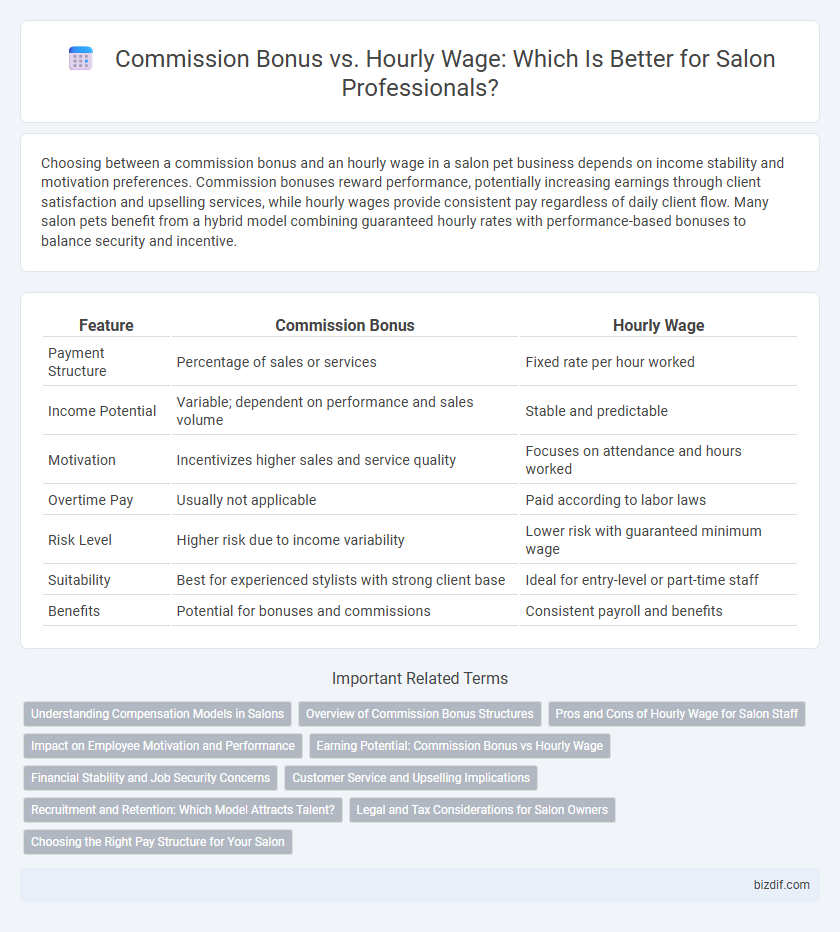Choosing between a commission bonus and an hourly wage in a salon pet business depends on income stability and motivation preferences. Commission bonuses reward performance, potentially increasing earnings through client satisfaction and upselling services, while hourly wages provide consistent pay regardless of daily client flow. Many salon pets benefit from a hybrid model combining guaranteed hourly rates with performance-based bonuses to balance security and incentive.
Table of Comparison
| Feature | Commission Bonus | Hourly Wage |
|---|---|---|
| Payment Structure | Percentage of sales or services | Fixed rate per hour worked |
| Income Potential | Variable; dependent on performance and sales volume | Stable and predictable |
| Motivation | Incentivizes higher sales and service quality | Focuses on attendance and hours worked |
| Overtime Pay | Usually not applicable | Paid according to labor laws |
| Risk Level | Higher risk due to income variability | Lower risk with guaranteed minimum wage |
| Suitability | Best for experienced stylists with strong client base | Ideal for entry-level or part-time staff |
| Benefits | Potential for bonuses and commissions | Consistent payroll and benefits |
Understanding Compensation Models in Salons
Commission bonus models in salons reward stylists based on a percentage of the revenue they generate, incentivizing higher client retention and upselling services. Hourly wage compensation provides a fixed income regardless of performance, offering stability but potentially limiting earning potential. Understanding these models helps salon owners attract and retain talent while motivating staff to deliver quality service and boost overall profitability.
Overview of Commission Bonus Structures
Commission bonus structures in salons typically reward stylists based on a percentage of the revenue generated from services and product sales, incentivizing higher performance and client retention. Common models include straight commission, tiered commission, and commission plus base wage, each designed to balance fixed income stability with earning potential. Understanding these structures enables salon owners to align compensation with business goals while motivating staff productivity.
Pros and Cons of Hourly Wage for Salon Staff
Hourly wage for salon staff ensures consistent income, providing financial stability regardless of client flow or appointment cancellations. However, it may limit earning potential compared to commission bonuses based on services sold or product recommendations, which can motivate higher performance. Employers benefit from predictable labor costs, but may face decreased staff motivation and lower productivity during slow periods.
Impact on Employee Motivation and Performance
Commission bonuses in salons directly tie earnings to individual sales and service quality, often boosting employee motivation and drive for higher performance. Hourly wages provide consistent income security but may not incentivize employees to maximize client engagement or upsell services. Salons offering commission bonuses typically see enhanced productivity and a more competitive atmosphere compared to those relying solely on hourly pay.
Earning Potential: Commission Bonus vs Hourly Wage
Commission bonus structures in salons often provide stylists with higher earning potential by directly rewarding performance and client retention, allowing top performers to maximize income through increased service sales and product recommendations. Hourly wages offer predictable and stable income but may limit overall earnings since pay does not vary with the number of clients or services performed. Stylists aiming for greater financial growth typically prefer commission bonuses, especially in high-traffic salons where client volume and service upsells are frequent.
Financial Stability and Job Security Concerns
Commission bonuses in salons can offer higher earning potential tied to performance, attracting ambitious stylists seeking financial growth. Hourly wages provide consistent income, ensuring financial stability and reducing stress related to unpredictable client flow. Many salon professionals prioritize job security and steady pay, valuing predictable earnings over variable commissions for long-term financial planning.
Customer Service and Upselling Implications
Commission bonuses incentivize salon employees to enhance customer service by rewarding them for upselling services and products, which directly increases salon revenue. Hourly wages provide stable income but may lead to less motivation for staff to engage customers actively or suggest premium treatments. Balancing both compensation methods can optimize employee performance and customer satisfaction, fostering a growth-oriented salon environment.
Recruitment and Retention: Which Model Attracts Talent?
Commission bonus models in salons often attract highly motivated stylists eager to maximize earnings based on performance, directly linking income with client satisfaction and service quality. Hourly wages provide stability and predictability, appealing to individuals who prioritize consistent income and work-life balance, which can enhance long-term staff retention. Salons balancing competitive commission incentives with guaranteed hourly pay tend to experience stronger recruitment outcomes and higher employee loyalty.
Legal and Tax Considerations for Salon Owners
Salon owners must carefully evaluate commission bonus versus hourly wage structures to ensure compliance with labor laws and tax regulations, minimizing legal risks. Commission-based pay requires accurate tracking of sales and services to comply with minimum wage laws and avoid wage disputes, while hourly wages must adhere to overtime and record-keeping standards. Proper classification impacts payroll taxes, workers' compensation, and unemployment insurance, making consultation with legal and tax professionals essential for optimal compensation strategies.
Choosing the Right Pay Structure for Your Salon
Choosing the right pay structure for your salon depends on factors like employee motivation, budget stability, and service volume. Commission bonuses incentivize stylists to increase sales and client retention by rewarding performance-based earnings, leading to higher revenue potential. Hourly wages provide predictable costs and steady income for employees, supporting team stability and consistent service quality.
Commission Bonus vs Hourly Wage Infographic

 bizdif.com
bizdif.com